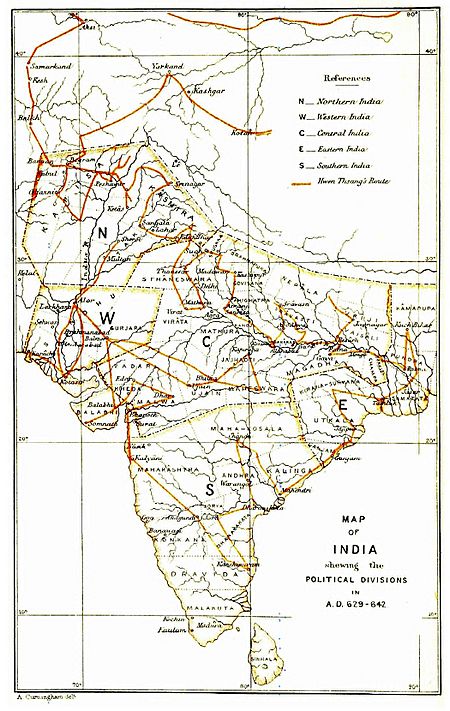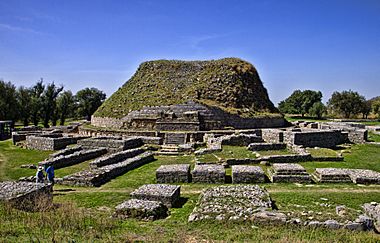Xuanzang facts for kids
Quick facts for kids Xuanzang |
|
|---|---|
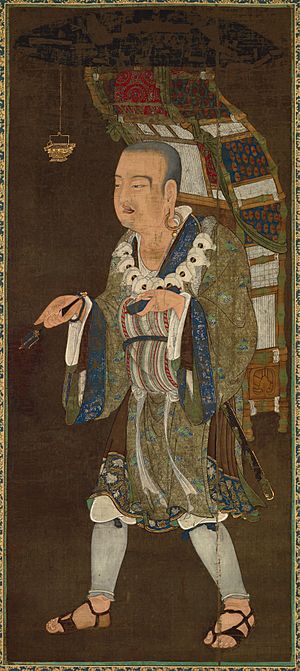
Painting of Xuanzang. Japan, Kamakura Period (14th century).
|
|
| Religion | Buddhism |
| School | East Asian Yogācāra |
| Personal | |
| Born | 6 April 602 Luoyang, Henan, China |
| Died | 5 February 664 (aged 61) Tongchuan, Shaanxi, China |
| Religious career | |
| Students | Kuiji |
| Xuanzang | |||||||||||||||||||||||||||||||||||
|---|---|---|---|---|---|---|---|---|---|---|---|---|---|---|---|---|---|---|---|---|---|---|---|---|---|---|---|---|---|---|---|---|---|---|---|
| Chinese name | |||||||||||||||||||||||||||||||||||
| Chinese | 玄奘 | ||||||||||||||||||||||||||||||||||
|
|||||||||||||||||||||||||||||||||||
| Chen Hui | |||||||||||||||||||||||||||||||||||
| Traditional Chinese | 陳褘 | ||||||||||||||||||||||||||||||||||
| Simplified Chinese | 陈袆 | ||||||||||||||||||||||||||||||||||
|
|||||||||||||||||||||||||||||||||||
| Chen Yi | |||||||||||||||||||||||||||||||||||
| Traditional Chinese | 陳禕 | ||||||||||||||||||||||||||||||||||
| Simplified Chinese | 陈祎 | ||||||||||||||||||||||||||||||||||
|
|||||||||||||||||||||||||||||||||||
| Sanskrit name | |||||||||||||||||||||||||||||||||||
| Sanskrit | ह्वेन त्सांग | ||||||||||||||||||||||||||||||||||
Xuanzang ([ɕy̯ɛ̌n.tsâŋ], Chinese: 玄奘; 602–664) was a famous Chinese Buddhist monk, scholar, traveler, and translator. He was born as Chen Hui or Chen Yi. He is known for his amazing journey to India between 629 and 645 CE. He brought back over 657 Indian texts to China and translated many of them.
Xuanzang was born on April 6, 602, in Chenliu, which is now part of Henan province. From a young age, he loved reading religious books. Like his older brother, he studied Buddhism at Jingtu monastery. Xuanzang became a novice monk at 13.
Because of political problems in China, he moved to Chengdu in Sichuan. There, he became a full monk at 20. He traveled across China looking for important Buddhist books. Eventually, he reached Chang'an, the capital city. Here, he decided he wanted to visit India. He knew that some Buddhist texts in China were incomplete or misunderstood. He wanted to find original texts in Sanskrit from India to help fix these problems.
At 27, Xuanzang started his 17-year journey to India by land. He went against his country's rules that banned travel abroad. He traveled through Central Asian cities like Khotan to reach India. He visited many places, including the famous Nalanda monastery in modern-day Bihar, India. There, he studied with the monk Śīlabhadra.
He left India with many Sanskrit texts, carried on 20 horses. When he returned to China, Emperor Taizong of Tang welcomed him. The emperor encouraged him to write about his travels. His Chinese travelogue, Great Tang Records on the Western Regions, is an important book. It tells us about Xuanzang's journey and about India and Central Asia in the 7th century. This book later inspired the famous novel Journey to the West.
Contents
Early Life and Studies
Xuanzang was born Chen Hui on April 6, 602. His family was known for being very smart and educated. Xuanzang was the youngest of four children. His family had important ancestors, including a minister from the Eastern Han dynasty.
His older brother was already a Buddhist monk. This inspired Xuanzang to become a monk too. After his father died in 611, he lived with his brother at Jingtu Monastery in Luoyang. He studied Mahayana Buddhism and other early Buddhist teachings there.
In 618, the Sui Dynasty fell, causing unrest. Xuanzang and his brother moved to Chang'an, the new capital of the Tang dynasty. Then they went south to Chengdu, Sichuan. They spent a few years studying more advanced Buddhist texts.
Xuanzang became a fully ordained monk in 622, at age 20. He noticed that Chinese translations of Buddhist texts often had mistakes or didn't agree. This made him want to go to India. He hoped to find the original Sanskrit texts to solve these problems.
His Great Pilgrimage
Xuanzang began his journey to India in 629 CE. He did not write his own travel story. Instead, he told it to other monks after he returned. Three of his friends wrote down his biography, which gives us details about his trip.
Journey Through Central Asia
In 630 CE, Xuanzang reached the kingdom of Agni (in Turpan). The king there was a Buddhist and tried to convince Xuanzang to stay. But Xuanzang wanted to continue his journey. The king helped him with letters and money for his travels. Xuanzang saw that the monasteries in Agni followed an older form of Buddhism.
Moving west, Xuanzang passed through the country of Kuchi. This area had many monasteries with thousands of monks. They studied Buddhist texts in the "original Indian language."
He continued west, crossing the Tian Shan mountains. He met the great Khagan, a leader of the Göktürks. After a feast, Xuanzang traveled southwest to Tashkent, in modern Uzbekistan. He described more monasteries and places with Buddha's footprints. He noted that an older form of Buddhism was common in these areas.
From there, he crossed deserts, icy valleys, and the Pamir range. He described the wind as "piercingly cold." He then crossed a salty sea, which he called the Great Pure Lake. His travelogue quickly listed many countries before he reached Baktra. He noted that Hinayana Buddhist schools were followed in all these regions.
In Baktra, Xuanzang saw a monastery with a Buddha statue decorated with jewels. This monastery was often raided by Turk chieftains who wanted to steal the jewels.
Reaching Bamiyana
South of Baktra, Xuanzang crossed the Great Snow Mountains. He then arrived in the country of Bamiyana (part of modern Afghanistan). Here, he saw a huge standing Buddha statue carved from a mountain rock. It was about 140 feet tall and decorated with gems. There was also a large copper Buddha statue, over 100 feet tall. East of a monastery, he saw a Reclining Buddha statue, over 1,000 feet long. The people and king of this valley respected the Buddhist monks.
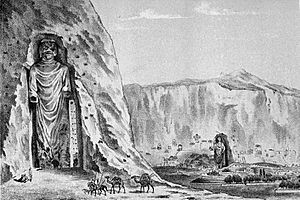
Heading east, Xuanzang described the country of Kapishi. Here, the Mahayana tradition of Buddhism was popular. It had over 100 monasteries and more than 6,000 monks. His travelogue also mentioned over ten Hindu temples. The people of this country remembered "King Kanishka of Gandhara" (from the 2nd century CE).
Exploring India
Xuanzang entered India after crossing the Black range. He called India "Indu." He described India as a huge country with 70 kingdoms. It was rich and fertile, with many plants. He noted their ancient customs, like measuring distance in "yojana."
He described Indian cities with square walls and narrow, winding streets. Shops lined the roads. People who worked as butchers or scavengers were not allowed to live inside the cities. Homes were made of bricks or wood. Children started school at age seven, learning grammar, technical skills, medicine, and logic.
Xuanzang also wrote about the differences between Buddhist groups. He said there were 18 sects, and they often debated. Each group had different rules for monks. Monks who could explain more Buddhist texts received better rooms and more help.
Northwest India
Xuanzang described Lampaka (modern Laghman) as part of north India. All monasteries there studied Mahayana Buddhism. He also noted many Hindu temples. To its southeast was Nagarahara, with many Buddhist monasteries but few monks. Both Lampaka and Nagarahara were independent but had become part of the Kapishi kingdom.
The monasteries in these kingdoms were beautiful, with towers and decorated halls. Indians painted their walls and doors with colors and pictures. Xuanzang also mentioned stories of glowing Buddha footprints and a Buddha's eyeball relic.
About 200 kilometers southeast was the country of Gandhara (now Peshawar, Pakistan). This was the land of ancient wise men and writers. Xuanzang visited many holy Buddhist sites here. He called the stupas and Buddha images "magnificent."
Kashmir and Beyond
Heading north, Xuanzang reached Pushkalavati, with many holy Buddhist sites. Then he came to Udayana, where the Subhavastu river flowed. This area once had many monasteries, but most were now empty. He saw monuments linked to the Buddha's past lives.
Xuanzang arrived in Taxila after crossing a river. He visited a major Buddhist monastery there. After traveling further, he passed through Simhapura and Urasa, then entered Kashmira. The king and many monks welcomed him. Kashmira had a cold climate but was calm. It had over 100 monasteries and more than 5,000 monks. Xuanzang stayed in Kashmira for two years to study.
Xuanzang often described how both Buddhists and non-Buddhists helped him. For example, he told a story about being robbed in a forest. A Brahmin farmer helped him and his friends by gathering villagers to rescue them.
Central India
Xuanzang visited the country of Mathura, in central India. This area was fertile, and people loved mangoes. The climate was hot, and people were kind. Mathura had over 20 monasteries with more than 2,000 monks. Many Hindu temples were also found here. He saw rituals where people carried and worshipped Buddha statues with flowers.
After crossing the Ganges river, he entered Matipura. Here, about half the people were Buddhist and half followed other religions. The climate was cooler, and people were honest. Matipura had ten monasteries and over 800 monks. It also had over 50 Hindu temples. He described the city of Mayura, a popular pilgrimage site near the Ganges. People from all over India came to bathe there.
Holy Buddhist Sites
In his travelogue, Xuanzang focused on some of the holiest Buddhist sites. He started with Shravasti (now in Uttar Pradesh). He described the capital city as empty, though some people still lived there. Many monasteries were ruined. He saw the remains of ancient palaces and stupas. He also saw a Buddhist temple with a seated Buddha image, which was in good condition.
From Shravasti, Xuanzang traveled to Kapilavastu. This country had no single ruler, and most monasteries were ruined. About 3,000 monks still studied there. He described many monuments and legends about the Buddha's early life in this region.
He then went to Kushinagara, where towns were deserted. He described a large brick temple with a reclining Buddha statue. He saw many sites where legends about the Buddha took place, including where he was cremated.
Xuanzang visited Baranasi (now Varanasi). He said the city was crowded and its people were "enormously wealthy." Few people were Buddhist; most were Hindu. The country had over 30 Buddhist monasteries and over 100 Hindu temples. He described a great stupa built by Ashoka.
He also visited Vaishali, where people were honest. This country had hundreds of monasteries, but only a few were in good condition. After Vaishali, he went north to Nepala, near the Snow Mountains. He said people there were skilled in crafts. Buddhist monasteries and Hindu temples were close together, and people believed in both.
Nalanda and Southern India
Xuanzang arrived in Magadha, a fertile land where people respected Buddhism. Magadha had 50 monasteries and over 10,000 monks. He described ancient cities like Kusumapura and Pataliputra. He saw many ruined Buddhist and Hindu monuments. He visited the Tiladhaka monastery, where thousands of monks studied Mahayana Buddhism.
After visiting many other sites, Xuanzang arrived at Rajagriha city (Rajgir) and the famous Nalanda monastery. He stayed and studied at Nalanda.
At Nalanda, he was with thousands of monks. Xuanzang studied logic, grammar, Sanskrit, and the Yogacara school of Buddhism with his teacher, Silabhadra. He described Nalanda as a beautiful place with "azure pools" and "mango trees."
From Nalanda, Xuanzang traveled through several kingdoms, including Iranaparvata and Champa. He visited Pundravardhana and Sylhet (in modern-day Bangladesh). He found 20 monasteries with over 3,000 monks. He also visited Kamarupa (Assam) and other regions in eastern India.
Xuanzang then traveled south to Andhradesa to visit monasteries at Amaravati Stupa and Nagarjunakonda. He stayed at Amaravati and studied texts. He then went to Kanchi, a strong center of Buddhism. From there, he traveled to Nasik, Ajanta, and Malwa, before returning to Nalanda.
King Harshavardhana invited Xuanzang to Kannauj for a great Buddhist assembly. Many kings, monks, and religious leaders attended. King Harsha also invited Xuanzang to the Kumbh Mela in Prayag, where he saw the king give many gifts to the poor.
After visiting Prayag, he returned to Kannauj and received a grand farewell. Traveling through the Khyber Pass and the Hindu Kush, Xuanzang passed through Kashgar, Khotan, and Dunhuang on his way back to China. He arrived in the capital, Chang'an, on February 5, 645 CE. His return was celebrated with a great procession.
Return to China
When Xuanzang returned to China in 645 CE, he was honored. However, he refused high government jobs offered by Emperor Taizong of Tang. Instead, he went to a monastery and spent his time translating Buddhist texts. He continued this work until his death in 664 CE. He brought back over 600 Buddhist texts, seven Buddha statues, and more than a hundred relics.
To celebrate Xuanzang's amazing work, Emperor Gaozong of Tang ordered two stone tablets to be made. These tablets, called The Emperor's Preface to the Sacred Teachings, were placed at the Giant Wild Goose Pagoda.
Impact on Chinese Buddhism
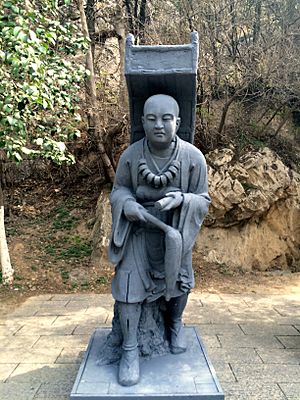
During his travels, Xuanzang studied with many famous Buddhist teachers. When he returned, he brought 657 Sanskrit texts. With the emperor's help, he set up a large translation office in Chang'an (now Xi'an). Students and helpers from all over East Asia joined him. He is credited with translating about 1,330 parts of scriptures into Chinese.
Xuanzang was especially interested in the Yogācāra school of Buddhism, which focuses on "Consciousness-only." His work on Yogacara in the 7th century greatly influenced Chinese Buddhism and then East Asian Buddhism.
His studies and translations led to the development of the Faxiang school in East Asia. Some of Xuanzang's students, like Kuiji and Wŏnch'ŭk, became important writers themselves. Even though the Faxiang school didn't last long, its ideas about perception, consciousness, Karma, and rebirth influenced other Buddhist schools.
Xuanzang was known for his careful translations of Indian Buddhist texts. These translations have helped people find lost Indian Buddhist texts from the Chinese copies. His translation of the Heart Sutra is still very important in all East Asian Buddhist groups.
His Own Writings
Even though Xuanzang is mostly known for his translations, he also wrote some original books.
In 646, at the Emperor's request, Xuanzang finished his book Great Tang Records on the Western Regions. This book is a main source for learning about medieval Central Asia and India.
Xuanzang also wrote a large book on Yogacara Buddhist philosophy, called the Ch'eng wei-shih lun.
There is another original text called Pa-shih kuei-chu sung (Verses on the Structure of the Eight Consciousnesses).
A biography of Xuanzang was written by the monk Huili. Both of these books were later translated into English.
Legacy and Fiction
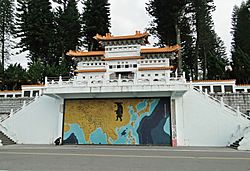
Xuanzang's book, Great Tang Records on the Western Regions, is the longest and most detailed account of Central and South Asian countries from a Chinese Buddhist traveler. His main goal was to get Buddhist books and learn about Buddhism in India. But he also recorded important details about the political and social life of the places he visited.
His records of places in Bengal have been very helpful for understanding the history of that region. Xuanzang brought and translated 657 Sanskrit Buddhist works. He received the best Buddhist education he could find in India.
His version of the Heart Sutra is used for all Chinese explanations of the sutra. It is also recited in China, Korea, and Japan.
In Fiction
Xuanzang's journey along the Silk Road inspired the Ming novel Journey to the West. This is one of the greatest classics of Chinese literature. In the story, Xuanzang, called Tang Sanzang, is a reincarnation of a disciple of Gautama Buddha. He is protected on his journey by three powerful helpers. One of them, the monkey, became very popular. This character has greatly influenced Chinese culture and modern Japanese manga and anime, including Dragon Ball and Saiyuki. He also became well known in the West through Arthur Waley's translation and the TV series Monkey.
In the Yuan Dynasty, there was also a play by Wu Changling about Xuanzang getting scriptures.
The movie Da Tang Xuan Zang was released in 2016. It was a Chinese and Indian production.
Relics
A skull relic believed to be Xuanzang's was kept in the Temple of Great Compassion, Tianjin. In 1956, it was taken to Nalanda and given to India. The relic was in the Patna Museum for a long time. In 2007, it was moved to a new memorial hall in Nalanda. The Wenshu Monastery in Chengdu, Sichuan province, also claims to have part of Xuanzang's skull.
Some of Xuanzang's remains were taken from Nanjing by Japanese soldiers in 1942. They are now kept at Yakushi-ji in Nara, Japan. In November 1965, the Japanese government returned the relic to the Taiwanese government. It is now kept in Xuanzang Temple, Taiwan.
Images for kids
-
Statue of Xuanzang in the Giant Wild Goose Pagoda, Xi'an
-
An illustration of Xuanzang from Journey to the West, a fictional account of travels.
-
Statue of Xuanzang. Great Wild Goose Pagoda, Xi'an.
See also
 In Spanish: Xuanzang para niños
In Spanish: Xuanzang para niños
- Cheng Weishi Lun
- Great Tang Records on the Western Regions
- Giant Wild Goose Pagoda
- Silk Road transmission of Buddhism
- Faxian
- Yijing
- Xuanzang Temple, Nantou County, Taiwan


